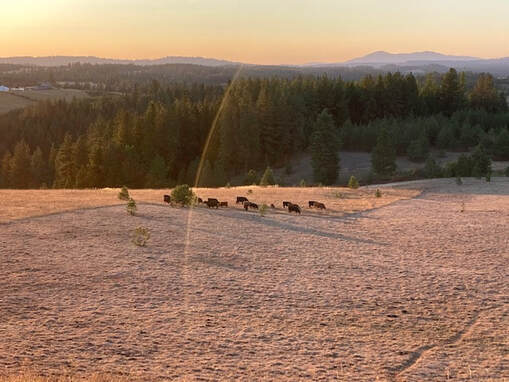OVERVIEW OF 2022 PRICE CHANGES
In 2021, our region experienced what the US Drought Monitor called category D4 Exceptional Drought Conditions. These extreme conditions impacted our farm and our production costs in the following way:

- Loss of forage:
In our grazing program, we rely on forage to feed our animals. We also plan our births and harvests to correspond with seasons of peak forage and nutrients. Last season, forage was too sparse to graze in most places, and there was not enough moisture in the soil for it to recover to be re-grazed. This required us to supplement our animals with hay that would normally be reserved for winter. The cost of a forage-raised animal is determined by our labor and land costs, but having to supplement hay early adds that cost to our bottom line. - Scarcity of hay:
Hay yields in 2021 were 50% of normal. Most of the large hay producers in the area used the small amount of hay they harvested to fill their annual export orders, leaving an extreme shortage of hay on the market for local producers. This drove up up the price of hay, in spite of poor yields and quality. Because local availability dried up before winter, we had to source hay many hours away. Rising fuel costs made these trips extremely expensive. Skyrocketing hay prices has impacted the cost of our beef this year and will likely increase costs next year as well. - Scarcity of grain:
The Palouse is one of the largest grain growing regions in the world, and once again the drought caused grain and pulse crop yields to be less than 50% of normal. Again, most of this grain was shipped out to fulfill annual contracts and orders, leaving a scarcity of grain on the market. Lower quality grains that would ordinarily be sold as feed grain, went to meet human demand, leaving very little product on the market for producers like us. Grain costs went up 30% which affects pork costs in 2022.
Additional economic factors
The following international, political factors are currently impacting our pricing.
- Inflation in a post COVID economy
- Record high fuel prices: Travel costs to purchase grain and hay have doubled due to cost of fuel and the distance we must travel to find feed
- War in Ukraine: One impact of the war in Ukraine is that the region's fertilizer production has slowed or halted, and access to chemicals and fertilizers used in conventional grain and hay production has diminished. While our farm does not use fertilizers or chemicals to produce our forage, we are dependent on conventionally grown grains and hay to raise our animals, and unless farmers convert to employing regenerative principles in their crop production, shortages are likely. It is hard to know the impact these shortages will have on our costs and meat production, but the federal government is projecting food shortages in the coming months.
What are we doing differently?
At Texas Ridge, our focus is on regenerating land and soil. In response to the drought and political conditions, we have made the following adjustments to our program:
- We downsized our herds of pigs, goats and cattle in 2021 to reduce impacts and lower feed costs. Any unbred breeding stock was harvested or sold. Our remaining stock will continue to produce offspring, but it will take time to rebuild to the harvest numbers we have produced for the past several years.
- Obtaining more grazing land. We signed two new grazing leases in 2021, and are actively seeking more grazing and annual ground, so we can maintain our remaining herd and still rest the land adequately after it has been grazed. If you have land you would like us to graze, please contact us.
- Contracting with growers directly to purchase grain and hay that is grown sustainably, and grinding grain for ourselves to better control price and quality. We purchased grain grinding equipment in 2021 which has improved our independence from arbitrary rate changes not linked to market conditions.
- Adding revenue streams to the farm. We are constantly looking for additional ways to keep our farm self-sufficient and productive so that we can avoid compromising our regenerative model, and still provide quality food to our community.
What can you do to help?
Educate yourself about the situation and climate conditions
Continue to support local producers in spite of temporary price fluctuations and changes to harvest timelines
Pray for our area, our farm, and other local producers
Share your ideas, input and resources with us and others. You can email us directly here.
Continue to support local producers in spite of temporary price fluctuations and changes to harvest timelines
Pray for our area, our farm, and other local producers
Share your ideas, input and resources with us and others. You can email us directly here.

